アメリカ合衆国のファミリーダラー店舗数
2025年11月6日現在、アメリカ合衆国には9,488のファミリーダラー店舗があります。ファミリーダラーの拠点が最も多い州または準州はテキサス州で、1,266のサイトがあり、全体の約 13.3% を占めています。

アメリカ合衆国にはファミリー・ダラーがいくつありますか?
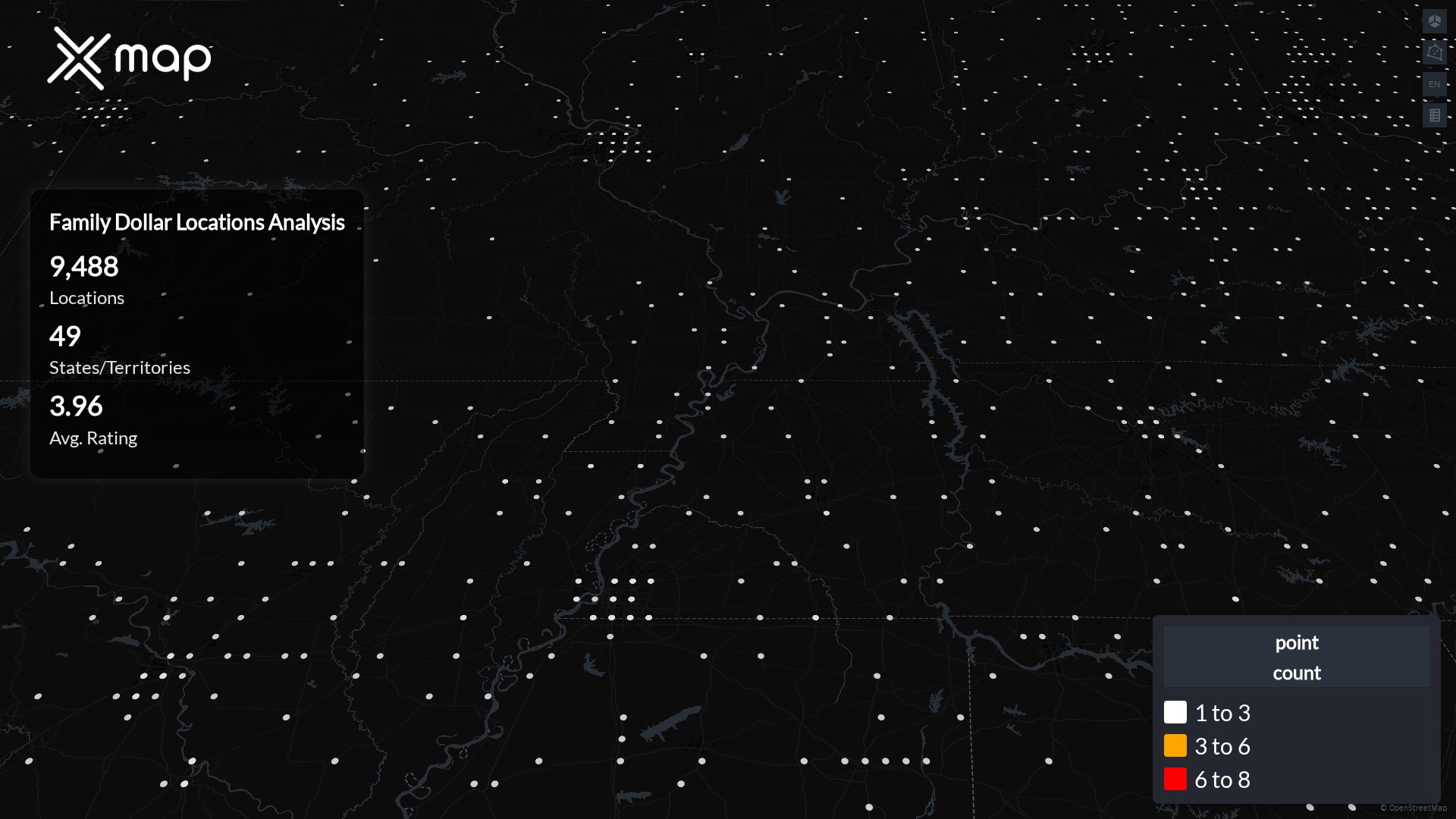
9,488
9,452
9,488
9,488
1,864
アメリカ合衆国全域の州別のファミリーダラー拠点の分布
ファミリーダラーは、49の州で9,488の米国拠点を運営しています。最大のクラスターはテキサス州、フロリダ州、オハイオ州で、上位10州にはサイトの 53.8% を占めています。オレゴン州、コロンビア特別区、ワシントン州では対象範囲が狭くなっています。
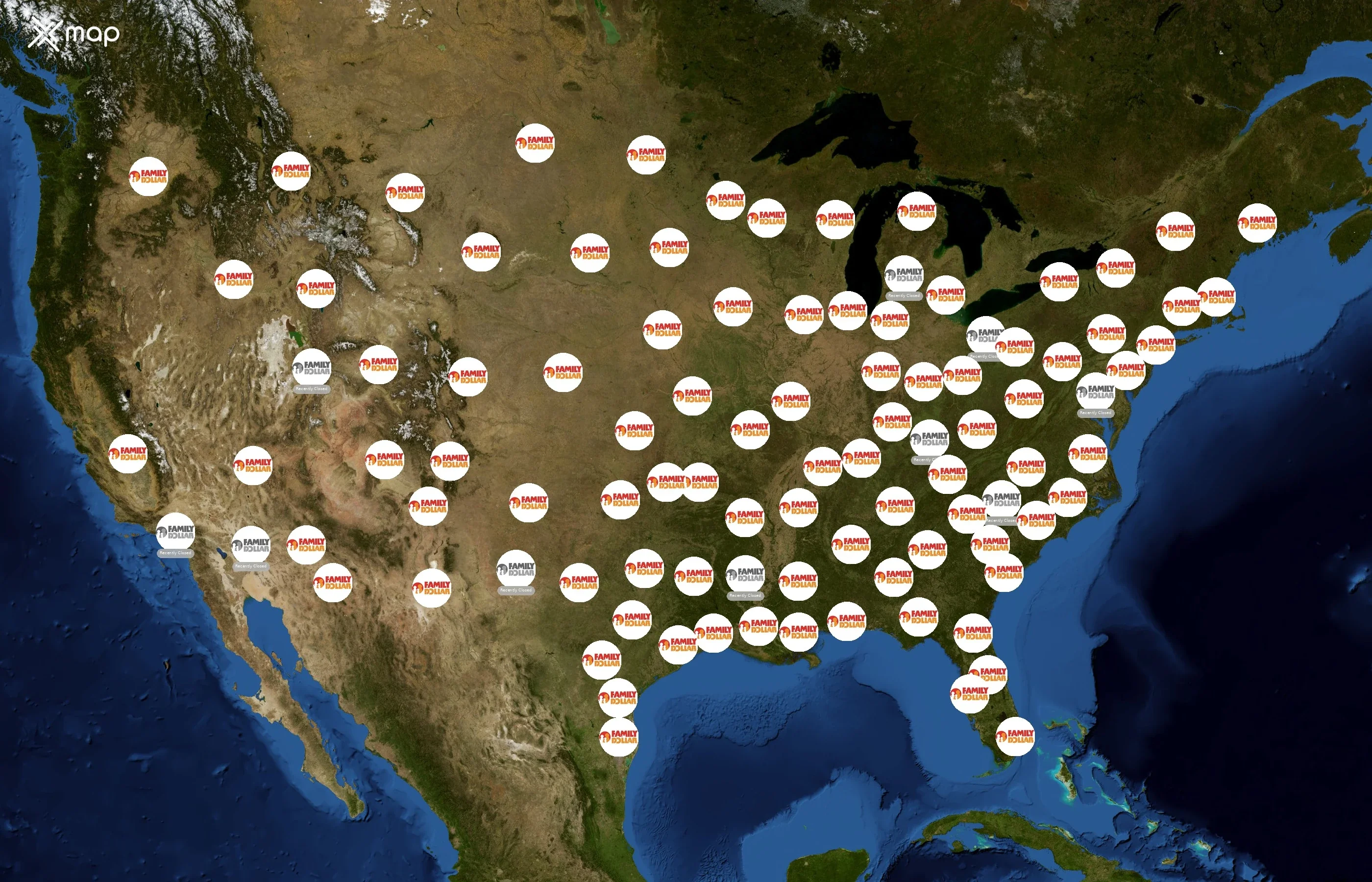
アメリカでファミリーダラーの店舗数が最も多い上位10州
Family Dollarは訪問者のエンゲージメントが強く、4152か所が平均トラフィックスコア(平均:58.55)を上回り、1030か所が高訪問者数として認められています。
ファミリーダラーは全米に合計9,488店舗を構えており、テキサス州が1,266店舗でリードしており、全体の13.3%を占めています。上位3州(テキサス州、フロリダ州、オハイオ州)は全店舗の 25.4% を占め、上位10州は 53.8% を占めています。ルイジアナ州は 12,576 人あたり 1 店舗というアクセスが最も良く、ワシントン州は居住者 2,562,850 人につき 1 店舗という最も広い地域です。
一人当たりのファミリー・ダラー・インサイト
- 米国(ルイジアナ州、ウェストバージニア州、ミシシッピ州)では、1人あたりのファミリーダラーへのアクセスが最も良好です。
- フロリダ州、ジョージア州、ミシガン州、ペンシルベニア州、ニューヨーク州などの州は、多数の拠点があるにもかかわらず、一人当たりのサービスが行き届いておらず、郊外への拡張需要が見込まれています。
- いくつかの州では、人口増加とファミリーダラー密度のバランスが取れており、競争が続くホットスポットとなっています。
アメリカでファミリーダラーの拠点数が最も多い都市
場所は、ヒューストン、シカゴ、ダラス、メンフィス、ニューヨークなどの主要メトロに集中しています。米国のサイトの 6.8% は上位 10 都市が占めています。
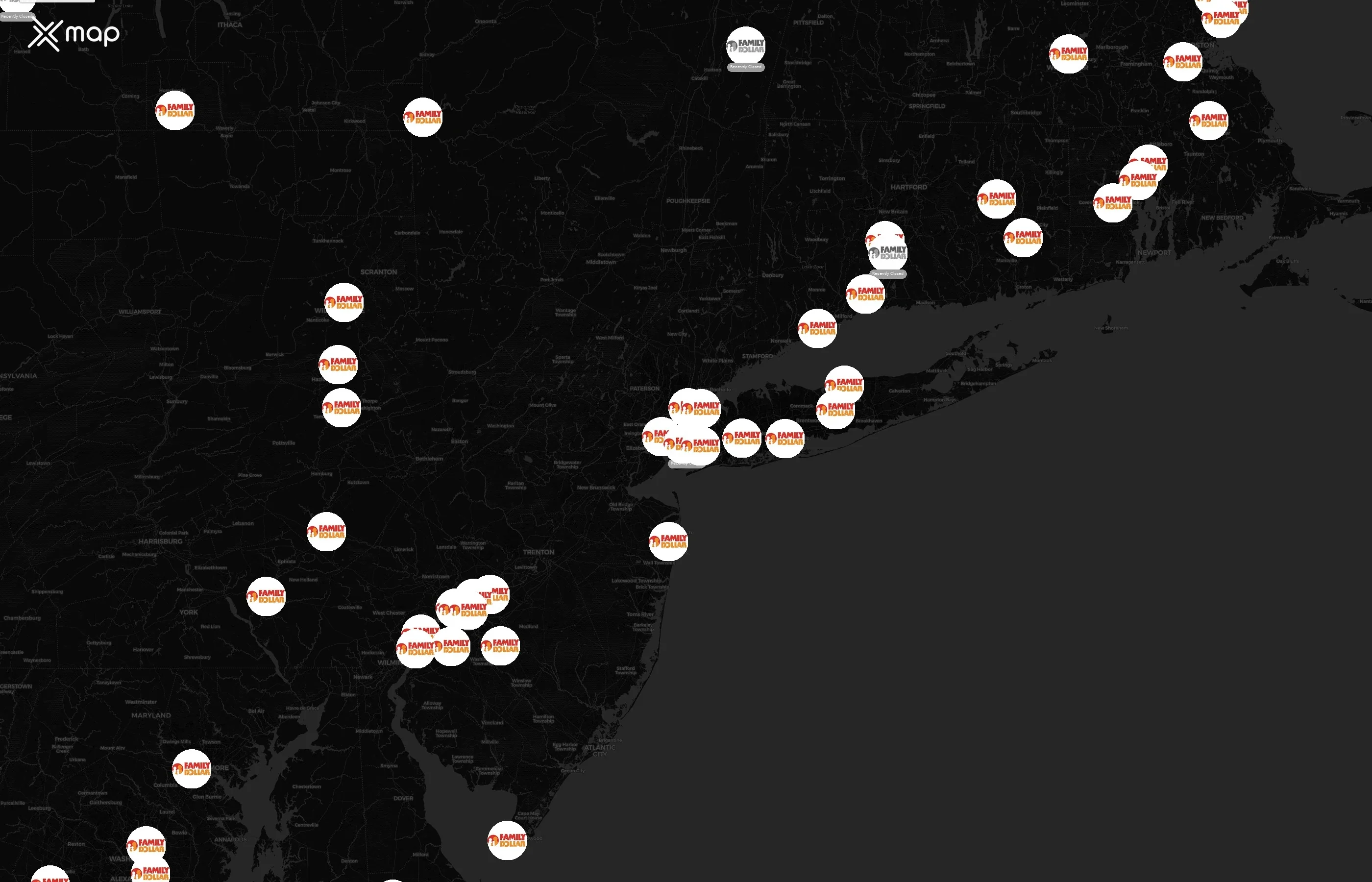
ロケーション数でランク付けされた都市トップ10
ファミリーダラーは全米で9,488店舗を運営しており、上位10都市がこれらの店舗の6.8%を占めています。テキサス州ヒューストンが131店舗で首位に立ち、続いてイリノイ州シカゴが77店舗を占めています。その他の注目すべき都市には、それぞれ 65 か所の拠点があるダラスとメンフィス、64 か所のニューヨークがあります。この分布は、上位 10 都市のうち 3 都市を擁するテキサス州に集中していることを浮き彫りにしています。
ストリートレベルのホットスポット(ファミリーダラーが複数ある最もにぎやかな通り)
ストリートレベルのクラスターは、同じ地域内にファミリーダラーの店舗が複数ある廊下を示しており、地域的な存在感と一貫性が強いことを示しています。ファミリーダラーは全国で合計9488店舗を運営しています。
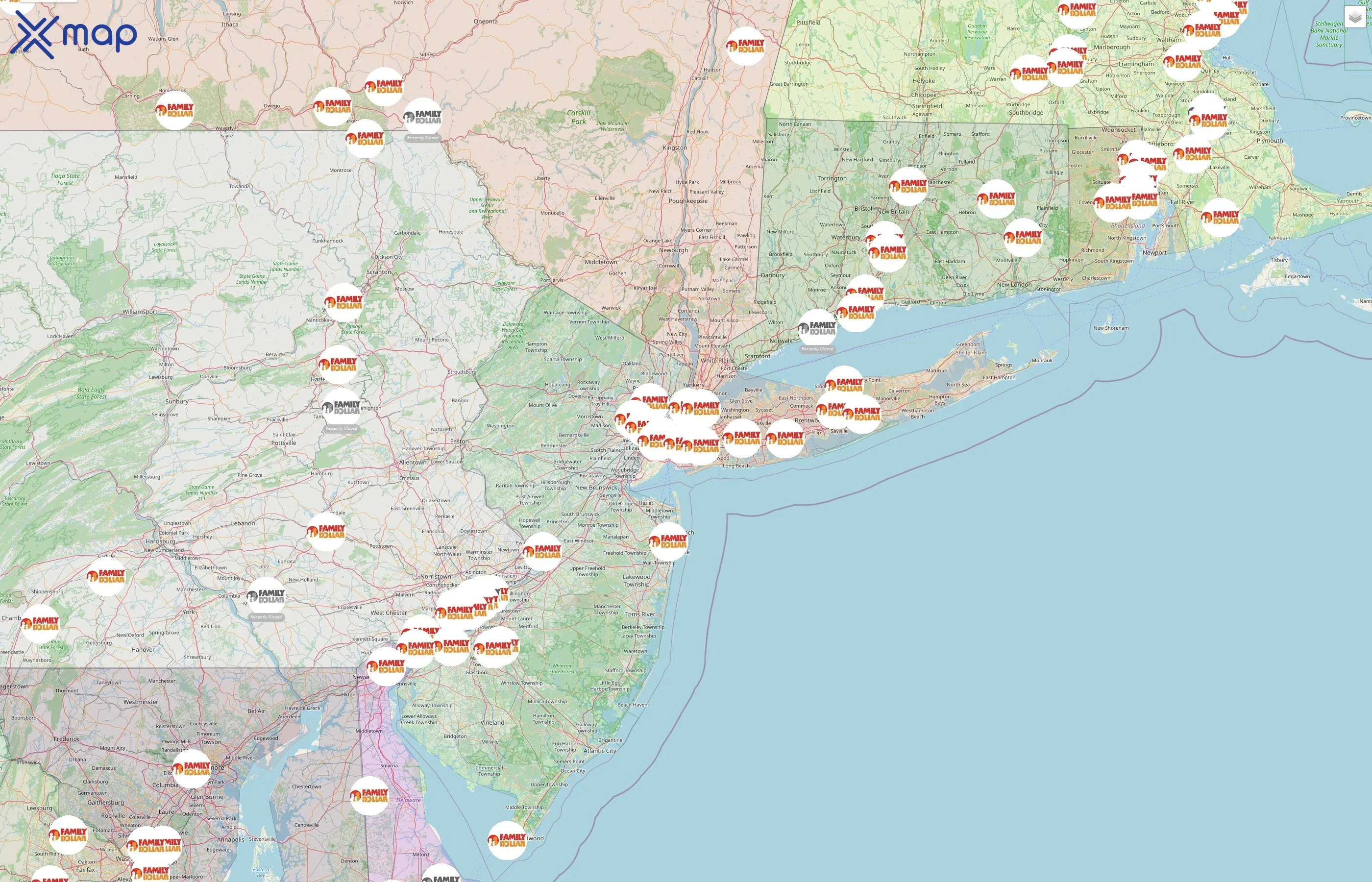
ファミリー・ダラー・アウトレットのポイント・オブ・インタレスト・データをダウンロード
座標、交通パターン、運行状況など、アメリカ合衆国全土のFamily Dollarロケーションの完全なデータセットをダウンロードできます。
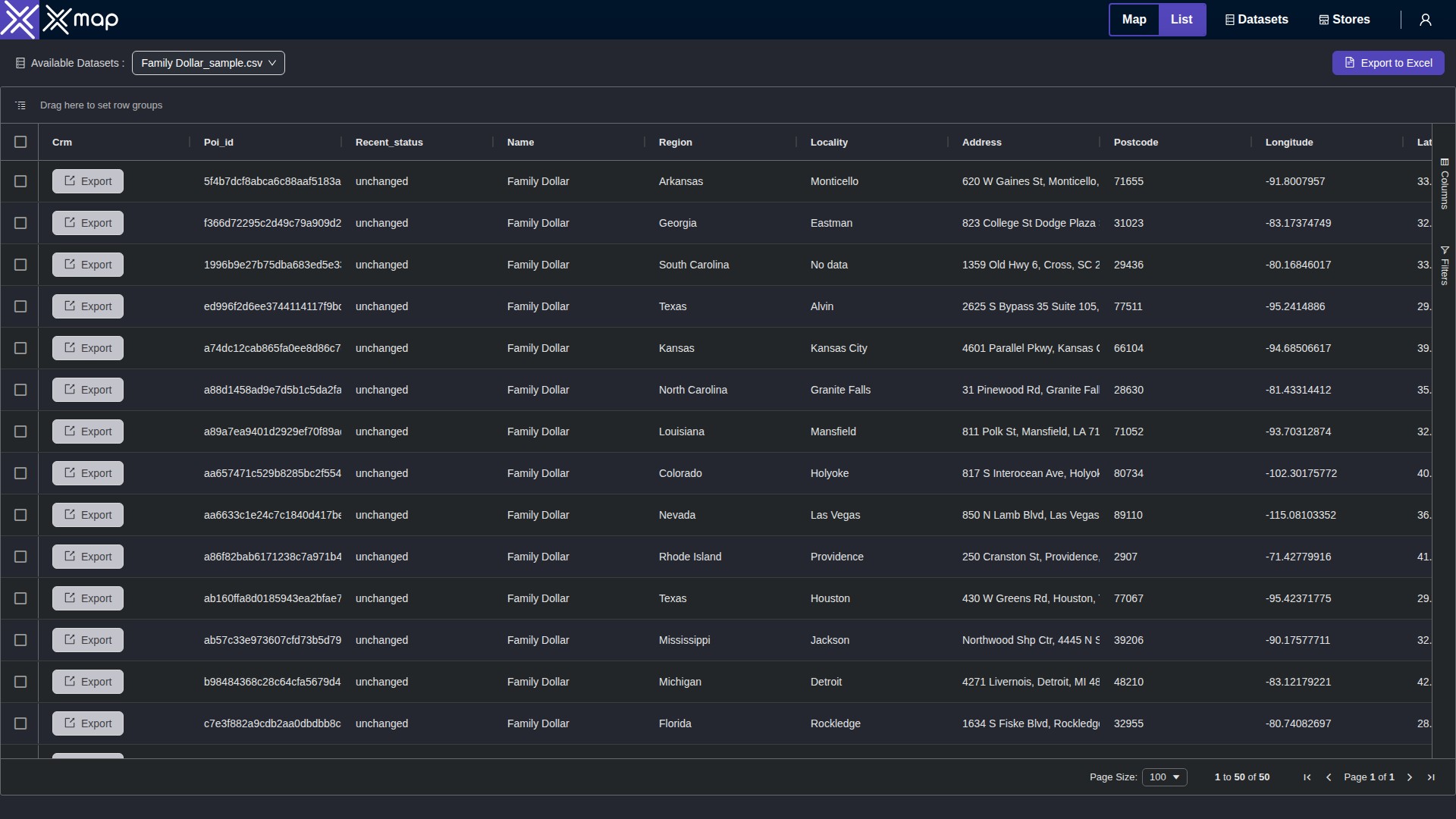
ファミリー・ダラー・ポイント・オブ・インタレストの主な変数
ファミリーダラーは、アメリカ合衆国全土に9488の店舗を構えています。主要な変数は、全国のファミリーダラー拠点に最も影響の大きい側面を示しています。これにより、さまざまな観点からファミリーダラーがどのように運営されているかが詳しくわかります。
ファミリー・ダラー・ロケーションあたりの平均カバーエリア(州別)

米国内のFamily Dollarの店舗は、土地面積の異なる複数の州に分散しています。テキサス州は695,668km²と記載されている最大の州で、上位の州の中でも最も多い1,266の拠点があります。サウスカロライナ州はデータ上最も小さい州で、82,940 km²、ファミリーダラー地域は 275 か所あります。その他の注目すべき州には、ミシガン州の面積が250,486km²と大きいにもかかわらず、619か所のフロリダ州と418か所のミシガン州があります。
ファミリーダラー店舗の事業状況(オープンとクローズ)
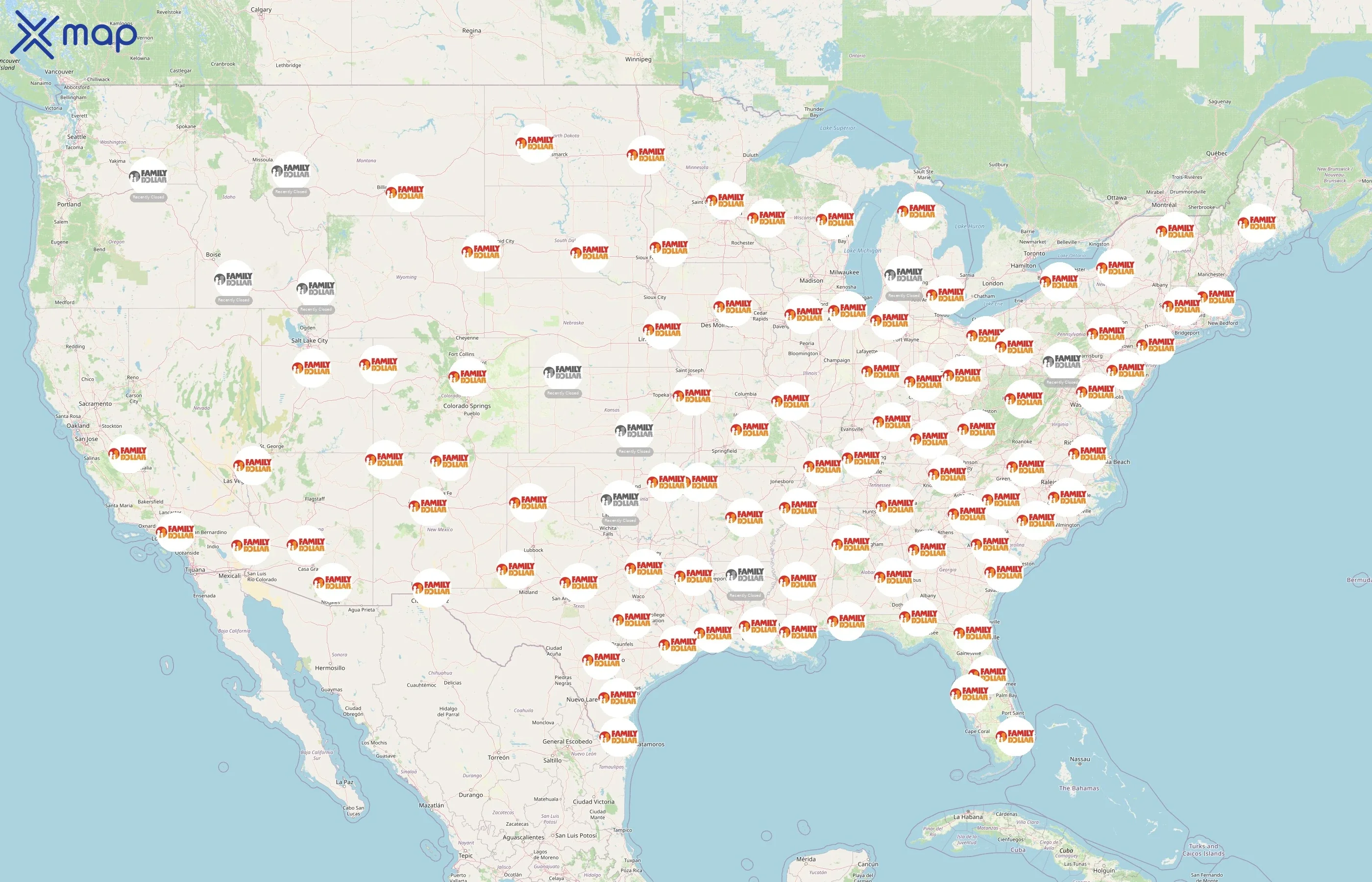
ファミリーダラーはテキサス州で最も店舗数が多く、1,266店舗あり、そのうち87.6%が営業しています。サウスカロライナ州は 89.5% と最も高い出店率を示しており、275店舗のうち246店舗が出店しています。開店率が最も低いのはオハイオ州とニューヨーク州で、それぞれ 76.8% と 75.4% です。フロリダ州とジョージア州はともに 80% 以上の店舗がオープンしており、それぞれ 512 店舗と 374 店舗がオープンしています。
ファミリーダラー店舗の交通データ (州別)
このビューでは、各州のファミリーダラーロケーション付近のアクティビティを比較しています。9,488 か所のサイトで観測されたトラフィックスコアを使用して、最も混雑している市場、平均以上の場所のシェアが高い州、およびアクティビティが比較的少ない地域が強調されています。パフォーマンスのベンチマーキング、現場業務の優先順位付け、事業拡大や最適化の機会の特定に活用してください。

上位10州で、ファミリーダラーのどの店舗が混雑していますか?
Family Dollarの米国内で最も繁忙な店舗はテキサス州に集中しており、全1,266店舗のうち278店舗が22.0%を占めています。サウスカロライナ州は繁忙店舗の割合が 23.3% と最も高く、275店舗のうち64店舗が占めています。フロリダ州、ジョージア州、ノースカロライナ州でも 20.8% から 21.1% の範囲で、混雑している店舗の割合が高くなっています。掲載されている州の中では、オハイオ州とニューヨーク州がそれぞれ 19.2% と 18.5% と最も低くなっています。
ファミリーダラーロケーションのカスタマーレビューと評価
このセクションでは、ファミリーダラーに対するお客様の感想をまとめています。9,488 か所の評価とレビューの合計を使用して、スコアが一貫して高く、フィードバックの量が最も多い場所に焦点を当てます。星による平均評価は質の高さを反映し、レビュー総数はネットワーク全体でのエンゲージメントとリーチを示します。

平均評価
Family Dollarの平均評価が最も高いのはルイジアナ州、ミシガン州、ノースカロライナ州、サウスカロライナ州、テキサス州です。総レビュー数はテキサス州が117,410件でトップで、フロリダ州が77,636件、オハイオ州が51,669件と続いています。また、平均評価とレビュー数の両方でミシガン州が上位にランクされており、レビュー数はそれぞれ 4.0 件と 43,229 件です。
レビュー数
Family Dollarの平均評価が最も高かったのは、ルイジアナ州、ミシガン州、ノースカロライナ州、サウスカロライナ州、テキサス州でした。総レビュー数はテキサス州が117,410件でトップで、続いてフロリダ州が77,636件、オハイオ州が51,669件でした。ミシガン州とジョージア州もレビュー数が多く、それぞれ 43,229 件と 42,274 件でした。
確認済みの連絡先情報が記載されたファミリーダラーの場所

連絡先情報
Family Dollarは、米国全土のすべてのリスト州で電話を完全にカバーしています。テキサス州が 1,266 か所で先頭に立ち、フロリダ州が 619 か所、オハイオ州が 525 か所と続きます。各州の電話カバレッジ率は 100% で、これらの州内のすべてのファミリーダラー店舗に電話が設置されていることがわかります。
ファミリー・ダラー・ポイント・オブ・インタレスト・データのユースケース
市場分析
ファミリーダラーのPOIデータにより、フットプリントと需要を明確に測定できます。アナリストは、州や都市を場所の数でランク付けし、対象地域を一人当たりで比較できます。また、トラフィックのスコアや調査量を活用して、業績の高い市場やサービスの行き届いていない地域を特定できます。その結果、飽和状態、成長機会、業績外れ値を客観的に把握できます。
サイト選択
ネットワーク計画では、このデータは、立地密度、場所ごとの人口、および近隣の交通量を使用して候補商圏をスコアリングするのに役立ちます。チームは、店舗から最も近い距離から競合リスクを評価したり、主要な通路に沿って空白を浮き彫りにしたり、観察された活動が最も活発な小売店街、キャンパス、交通機関に近い場所に優先順位を付けたりできます。
都市計画
計画担当者は、クラスターとサービスギャップをマッピングして、近隣レベルでの商業アクセスを把握できます。一人当たりの調査ではアクセスが制限されているコミュニティが強調され、開館や閉鎖の変化は活動の変化を示唆しています。これらの洞察は、回廊の活性化、街並みと交通計画、データ主導のゾーニングの決定に役立ちます。
このxMapのPOIデータは企業にどのように役立ちますか?
- 精度と精度: xMap データは精度の高いデータを提供するため、欠陥のある情報に基づいて誤った判断を下す可能性が最小限に抑えられます。
- 完全なデータ: xMapを使用すると、企業は包括的で完全なデータにアクセスできるため、知識のギャップを効果的に埋め、意思決定のための包括的なビューを提供できます。
- 最新情報: xMapは、提供されたデータが定期的に更新されることを保証します。これにより、企業は現在の傾向や状況に合わせて、動的でタイムリーな意思決定を行うことができます。
- スケーラビリティ: xMap データは、さまざまな事業規模や要件に対応するインサイトを提供することで、事業を効率的に拡大することができます。
- 分析力: xMapデータの分析を活用することで、パターンや傾向を特定できるため、企業の戦略的計画と予測が強化されます。


